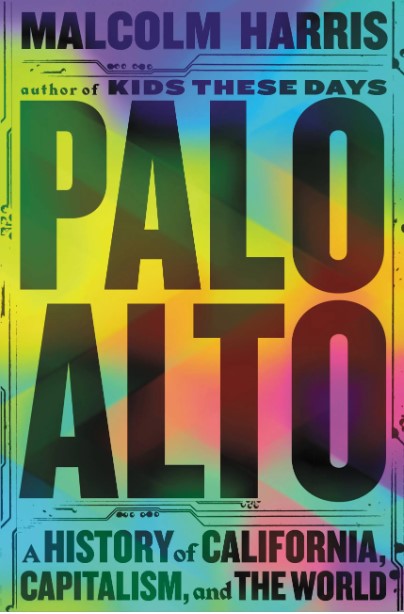Reviewed by Asher Kohn, AICP, December 19, 2022

“Palo Alto is haunted” is perhaps not what a reader would expect to learn just five pages into a 628-page tome. In a passage that sets the tone for how he uses historical materialism and conversational writing to describe 250 years of Bay Area history, author Malcolm Harris says that we can be haunted “by a loss or a traumatic event or even by that dumb thing we said that one time.”
In his recent book Palo Alto: A History of California, Capitalism, and the World, Malcolm Harris tells the story of how Silicon Valley came to be and what this evolution means for those touched by Silicon Valley’s creation – which is to say, all of us. Harris tells us that “Haunting happens when a past action won’t go away, won’t stay past.” This leads up to his thesis: What haunts are the kinds of large historical crimes that, once committed, can never truly be set right.
Harris is unflinching in his description of the “California model” developed during and exported after the Gold Rush, which he describes as “Anglos rule; all natives are Indians; all land and water is just gold waiting to happen.” Who makes up the “Anglos,” the “Indians,” and the natural resources is up for debate; at least amongst the Anglos, as we learn. According to Harris, this crude formula has become “the model for a new world, an integrated sphere of value and labor flows.”
Much of the book goes into the connections and relationships. As befits a book that begins with an epigraph by Karl Marx, Palo Alto takes pains to overturn any “great men of history” framing. If there is a protagonist, it’s Herbert Hoover, U.S. president and Stanford University alum, benefactor, and trustee. Rather than identify a specific “hero” for planners in the Bay Area to emulate, the book focuses on relationships – between cohorts, classes, and races – as key to these complex networks that span the globe.
Harris is the grandchild of settlers and uses the book to connect these relationships, as a haunting to “unseen lineages of historic responsibility.” City planners may not be the originators of the conquests described in Palo Alto, but they are its facilitators. Separation of the “Indians” from the land, water, and gold does not happen without the tools wielded by this profession. One does not, of course, have to reach all the way back to 1849: Euclidean zoning, suburban exclusion, and interstate rights-of-way all contribute to the rapid accumulation and appropriation that have occurred and are occurring. City planners are historical actors.
For a book whose concepts include global examples, Palo Alto exhibits mastery of local places. In East Palo Alto alone, Harris points to why a gang on a particular street became powerful, and then he connects the urban form of cul-de-sacs near highways to the lack of decent jobs in the area – typical urban planning stuff. But then he goes further by connecting these issues to things often understood as outside planning’s purview: the boom of the drug economy and the racial politics of schooling in Silicon Valley. Malcolm Harris has a planner’s ingenuity for the relationship between place and people, but a broader worldview than most of us. Even local issues have global ramifications, and vice-versa.
Nowhere is this clearer than in the hot-button issue of housing. A house is an investment in place and a home, and it is the most commonly-seen expression of property rights. Harris points out that the California Real Estate Association launched its Prop 14 campaign from Palo Alto. This 1964 ballot initiative to allow racial discrimination in housing (proposed after discrimination was forbidden by the Rumsford Fair Housing Act) won 65% of the statewide vote. He observes that the “winning” argument of Prop 14 emphasized housing as an investment and the Fair Housing Act as meddling. “If property rights are subject to popular control, then investors will encounter the public as an obstacle, a variable to be managed,” he writes. This is true whether the investor is a homeowner in the suburbs or, using another historical example by Harris, an oil company worried about a nationalizing prime minister in 1950s Iran. Property rights regimes and investment returns keep finding themselves on the wrong side of popular will. Ending exclusionary housing, according to Malcolm Harris, is part of a global struggle.
Planners who look back at the work of their profession in 20th-century California may only see wreckage upon wreckage: suburban sprawl, degraded nature, polluting highways, and so forth. It’s hard as a planner not to read Palo Alto and think of two famous questions, albeit ones not often asked in planning school: “What is to be done?” (Leo Tolstoy, 1886) and “Which side are you on?” (Florence Reese, 1931).
Our profession works in relation to land and to people, but that does not mean we have to relate to the current property regime outlined by Harris. As someone who works in long-range planning, I often think of certain communities rarely represented in my work – those who work in a place they can’t afford to live in, and those whose relationship to the land goes far beyond ownership of it.
The field of planning is at a critical juncture in California. The normative focus on ownership and investment is shifting as planners increasingly consider equity and sustainability as well. Thinking of these concepts as necessary ingredients to exorcize harms done by our profession is a way for me to think of how my work can support popular movements, such as those described in Palo Alto and largely consisting of people far braver than me. Reading Palo Alto, I was inspired by Harris’ perspective but also a bit intimidated by its scope and reach. The planning profession may be more about incremental gains than those outlined in the book, even if it’s part of a larger struggle. As I am part of this work, maybe we will win and maybe we won’t. But like any good exorcism, it at least helps me go to sleep at night.
Palo Alto: A History of California, Capitalism, and the World, by Malcolm Harris (Little, Brown, 2023) Hardback | Electronic, 720 pp., ISBN-13 9780316592031

Reviewer Asher Kohn, AICP, is a planner focused on the relationship between land use and demographic change. His work is based in the Peninsula and South Bay.

